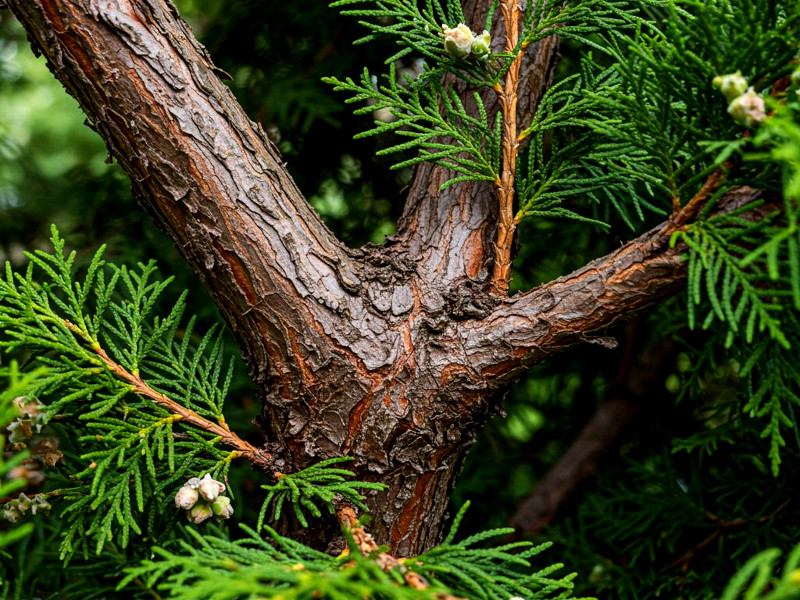Wise Mind Herbs
Evidence-based Herbal Healing
The information on this page has been prepared with reference to published scientific literature, not by a medically qualified expert. It is not medical advice. Any decision to use a supplement or herb-based product is your responsibility. Consult a suitably qualified medical professional, especially if you have underlying conditions. Remember, nothing is for everyone, and not everything sold is what it claims to be. Some things work for some people, some of the time.
Thuja occidentalis
Thuja is a genus of coniferous trees belonging to the family Cupressaceae. The most studied species for medicinal use is Thuja occidentalis, commonly known as Eastern white cedar, Northern white cedar, or Arborvitae ("tree of life"). This should not be confused with Thuja plicata (Western red cedar) or with various species of Platycladus, Chamaecyparis, or Juniperus that are sometimes erroneously referred to as "thuja" in folk medicine or commercial preparations.

Bioactive Compounds
The medicinal properties of Thuja occidentalis are attributed to various compounds including essential oils (primarily thujone, which has alpha and beta isomers), polysaccharides, flavonoids, tannins, and diterpenes. The essential oil contains approximately 60-70% thujone, along with fenchone, borneol, and camphor in smaller amounts. These proportions can vary significantly depending on harvest time, growing conditions, and plant part used.
Purported Health Benefits with Scientific Evidence
Despite its long history in traditional medicine, particularly in Native American and European contexts, high-quality clinical evidence for Thuja's efficacy remains limited. Most studies are in vitro or animal models, with few rigorous human clinical trials. The following represent areas where some scientific evidence exists:
- Antiviral activity: In vitro studies suggest activity against herpes simplex virus and influenza viruses, attributed to polysaccharide fractions.
- Immunomodulatory effects: Some research indicates Thuja may stimulate cellular immunity and cytokine production.
- Antioxidant properties: Several studies demonstrate free radical scavenging activity in laboratory settings.
- Anti-inflammatory effects: Animal models suggest some anti-inflammatory action, potentially beneficial in conditions like rheumatoid arthritis.
- Anticancer potential: Preliminary in vitro studies show cytotoxic effects against some cancer cell lines, though clinical relevance remains undetermined.
- Antimicrobial activity: Some evidence for antibacterial and antifungal properties against select pathogens in laboratory studies.
It is important to note that none of these potential benefits has been conclusively demonstrated in large, well-designed human clinical trials, and Thuja cannot be said to "cure" any condition based on current scientific evidence.
Dosage and Administration
No standardized dosing exists due to insufficient clinical trials. Traditional preparations vary widely and include:
- Tinctures: Typically 1:5 or 1:10 dilutions, with suggested doses of 0.5-2 mL, 1-3 times daily
- Tea/infusion: 1-2 g of dried leaves in 150 mL water, not recommended for regular consumption
- Homeopathic preparations: Various dilutions according to homeopathic principles
- Topical applications: Various ointments and oils, concentrations not standardized
No systematic studies have established dose-response relationships or maximum efficacious dosages. The lack of standardization in commercial products further complicates dosing recommendations.
Safety Concerns and Side Effects
Thuja contains thujone, a potentially neurotoxic compound that can cause serious adverse effects at high doses. Safety concerns include:
- Neurotoxicity: Seizures, convulsions, and cognitive disturbances at high doses
- Hepatotoxicity: Potential liver damage with prolonged use
- Gastrointestinal irritation: Nausea, vomiting, abdominal pain
- Allergic reactions: Contact dermatitis when applied topically
- Reproductive toxicity: Potential abortifacient properties; contraindicated in pregnancy
- Drug interactions: May interact with anticoagulants, anticonvulsants, and other medications
Studies specifically examining high-dose thuja administration are lacking, primarily due to ethical concerns given its known toxicity. This represents a significant knowledge gap in understanding dose-dependent effects. The limited research that exists suggests no additional benefits at higher doses, with significantly increased risk of adverse effects.
Pharmaceutical Products
There are currently no FDA-approved or EMA-approved pharmaceutical medications containing Thuja extracts or compounds. Some homeopathic and complementary medicine products contain highly diluted Thuja preparations, including:
- Thuja-Heel (Heel GmbH): Homeopathic preparation containing Thuja occidentalis and other ingredients
- Thuja Comp (Weleda): Homeopathic formulation for inflammatory conditions
- Lymphdiaral (Pascoe): Contains Thuja occidentalis among other botanicals
It should be emphasized that these are not conventional pharmaceutical products with demonstrated efficacy through rigorous clinical trials, but rather complementary medicine preparations.
Research Limitations and Knowledge Gaps
Significant limitations in the research literature include:
- Few randomized controlled trials in humans
- Small sample sizes in existing studies
- Lack of standardization in preparations used
- Inadequate reporting of adverse effects
- Limited long-term safety data
- Poor characterization of active constituents in many studies
Additionally, there is a notable absence of high-quality meta-analyses or systematic reviews specifically focused on Thuja's medicinal applications, reflecting the preliminary nature of the research field.
Conclusion
While Thuja occidentalis contains bioactive compounds with demonstrated in vitro and some in vivo effects, clinical evidence supporting its efficacy for specific health conditions remains insufficient. Potential toxicity concerns, particularly from thujone content, outweigh the evidence for benefits in most applications. Further rigorous research is needed before specific health claims or dosing recommendations can be supported by science. Individuals interested in thuja-containing products should exercise caution and consult healthcare providers, particularly given potential toxicities and interactions.
References
Caruntu, S., Ciceu, A., Olah, N. K., Don, I., Hermenean, A., & Cotoraci, C. (2020). Thuja occidentalis L.(Cupressaceae): Ethnobotany, phytochemistry and biological activity. Molecules, 25(22), 5416.
Darwish, R. S., Hammoda, H., Harraz, F. M., & Shawky, E. (2024). Genus Thuja: A comprehensive review on botany, traditional uses, pharmacological activities and phytochemistry. Journal of Advanced Pharmaceutical Sciences, 1(1), 100-120.
Gupta, M., & Sharma, K. (2021). A review of phyto-chemical constituent and pharmacological activity of Thuja species. Int. J. Pharm. Res. Appl, 6(1), 85-95.
Srivastava, A., Jit, B. P., Dash, R., Srivastava, R., & Srivastava, S. (2023). Thuja occidentalis: an unexplored phytomedicine with therapeutic applications. Combinatorial Chemistry & High Throughput Screening, 26(1), 3-13.
Thakur, M., Sobti, R., & Kaur, T. (2023). Medicinal and biological potential of Thuja occidentalis: A comprehensive review. Asian Pacific Journal of Tropical Medicine, 16(4), 148-161.